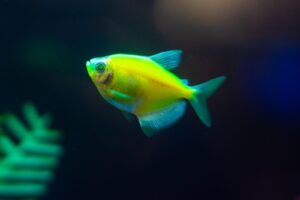
- 1 year health guarantee for all our exotic pets on sale
- [email protected]

Photo by Christina Gillette from Unsplash
When it comes to the world of aquariums, enthusiasts are continually in pursuit of unique and captivating additions to their collections. Among the countless choices available, exotic tetras hold a special allure. These vibrant and dazzling fish have the power to infuse your aquarium with a burst of color and vitality.
This authoritative guide will delve into the art of expertly caring for exotic tetras in your aquarium, ensuring their thriving presence in their aquatic abode.
Before delving into the details of care, it’s essential to make the appropriate selection of tetra species that suit your aquarium. There are over 150 distinct varieties of tetra fish, showcasing a wide range of colors, shapes, and sizes, they prove to be an excellent inclusion in any aquarium arrangement, catering to both newcomers to the hobby and experienced enthusiasts.
The exotic tetra family encompasses a wide variety of species, each with its unique characteristics. To fully appreciate this hobby of fish keeping, do proper research on the different species available to find the one that best suits your preferences and tank setup.
For instance, brightly colored Lemon Tetra species, prized for their peaceful and sociable nature. Adorned with sharp black-and-yellow fins and a yellow body, these fishes epitomize vibrancy when well-fed and nurtured. Prudent attention to diet, stress levels, and tank conditions can contribute significantly to their striking appearance. These tetras, scientifically known as Hyphessobrycon pulchripinnis, thrive in schools of six or more, showcasing captivating natural behaviors when kept in secure and comfortable surroundings.
The Neon Tetra, known for its ubiquity and popularity among aquarists of all skill levels, graces aquariums with its petite yet vibrant presence. These small wonders are ideal for beginners with compact 10-gallon tanks, but they also thrive in more expansive aquatic realms. Picture a sprawling, densely planted tank adorned with a substantial school of Neon Tetras—a captivating spectacle celebrated by aquarists worldwide.
Close kin to the Neon, the Cardinal Tetra boasts a slightly larger stature and a brilliant red stripe that stretches the length of its body. It offers a vivid alternative to its more common cousin. For those with larger tanks, consider the visually similar Green Neons and Black Neons, which are well-suited to 20-gallon environments.
Inhabitants of larger tanks, Black-skirt Tetras provide an eye-catching presence with their striking silver, black, and white patterns. While generally peaceful, their occasional nipping tendencies and susceptibility to fin damage due to their extended fins should be noted.
Common inhabitants in the aquarium trade, white-skirt Tetras share care requirements with their Black-skirt counterparts. These tetras tend to disperse throughout the tank rather than forming tight schools, only gathering closely in response to perceived threats.
Creating the perfect habitat for your exotic tetras is the first step to ensuring their well-being. Take into account these basic factors when setting up your aquarium:
Exotic tetras often come from regions with lush vegetation and complex underwater landscapes. Mimicking their natural habitat is crucial. Use live plants like Amazon swords, java ferns, or Vallisneria to create a lush, planted environment. Incorporate driftwood, rocks, and caves to provide hiding spots and territories. Look into these considerations as well:
Exotic tetras are sensitive to changes in water conditions. To keep them healthy and vibrant, maintain the following water parameters:
Water Quality and Filtration: Invest in a reliable filtration system to maintain pristine water quality. Regular water changes are also essential.
Proper nutrition is key to the longevity of your exotic tetras. Offer a varied diet that includes high-quality flake food, freeze-dried, and live or frozen foods. Ensure portion control to prevent overfeeding and water quality issues. A diverse diet promotes better overall health and vibrant coloration in tetras.
Exotic tetras are social creatures that thrive in the company of their own kind. These fishes can be somewhat timid, so choose tank mates carefully. Keeping them in schools of at least six individuals reduces stress and displays their natural schooling behavior. When selecting tankmates, avoid aggressive species that may harass or outcompete tetras. Peaceful community fish are generally good companions.
A suitable social environment for tetras positively impacts their behavior and stress levels. Avoid aggressive or nippy species that might stress them out. Compatible tank mates could include other peaceful community fish like rasboras, small catfish, or peaceful dwarf cichlids.
To ensure your tetras remain healthy, regular water changes are a must. Additionally, stay vigilant for common diseases such as fin rot and ich. Quarantine tanks are valuable for isolating sick fish and preventing the spread of illnesses within your aquarium. Proper maintenance and quarantine procedures significantly reduce the risk of disease outbreaks in tetra populations.
If you’re interested in breeding exotic tetras, understanding their unique needs is crucial. Create breeding conditions by simulating the rainy season with slightly cooler water and increased food. Separate fry from adult fish to protect the vulnerable young.
Research into tetra-breeding behavior can offer valuable insights into successful breeding techniques. Tetras employ various reproduction strategies, such as egg scatterers or egg layers. Studying these strategies can help aquarists and researchers understand the intricacies of tetra breeding. For example, knowing whether a particular tetra species lays eggs on the substrate or scatters them in plants can inform the design of breeding tanks and setups.

Photo by Christina Gillette from Unsplash
Keeping exotic tetras, including the brightly colored Lemon Tetra, in your aquarium can be a rewarding experience. By selecting the right species, setting up an ideal tank, maintaining water quality, providing a balanced diet, and understanding their social behavior and breeding requirements, you can ensure your tetras thrive in their aquatic home. Embrace the art of tetra keeping and watch your aquarium burst with vibrant colors and dynamic energy.
Copyright © 2025 Compound Exotics All Rights Reserved.